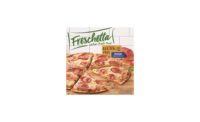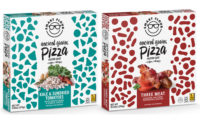What if yogurt cups were widened, so that spoons could rest inside and not topple the container? Or, what if the tops were sturdier, so they couldn’t be punctured or opened when dropped?
These and other issues were solved during the 2015 Wegmans Design Challenge, which was part of a fall semester class where students from the packaging science department of Rochester Institute of Technology’s (RIT) College of Applied Science and Technology the partnered with students from the industrial design and graphic design departments in the College of Imaging Arts and Sciences to create a more sustainable, user-friendly packaging concept.
“We know this is about design, marketability and improving the use of products, but I’m glad the teams emphasized sustainability,” says Jason Wadsworth, Wegmans sustainability manager and one of the judges for the competition. “Our Wegman’s customers are aware of sustainability and it matters to them and to us. I’m impressed with the work. This was a win.”
Eight teams re-worked packaging designs for two of Wegmans private label products—premium orange juice and Greek yogurt. All projects were to include strategies about changes in packaging structure, the materials used and improvements to graphic and ergonomic elements. They were also required to provide evidence of sustainable use and cost savings.
“Projects like this are so important to our academic careers because they broaden our knowledge and expand our creativity when looking at real-world problems with real-world parameters,” adds Laura Hoerner, a graphic design student on Team Moo, one of the winning teams. “We are able to work with peers in various majors with different ideas and thought processes. I have learned so much from working alongside the industrial designers and the packaging science majors. It provides a different experience than just working with other graphic design students.”
The winning Orange Juice Team 8 exchanged the traditional cardboard container with a clear, slimmed-down version that was fully recyclable. The new design allows for more products shipped on pallets, reducing the number of individual crated items and transportation impacts.
Team Moo won the Greek yogurt category with a box-like, stackable design that included a stronger lid to replace the foil usually found on the containers. Each of the flavors of the yogurt was indicated by color, and the Wegman’s Organic leaf logo was prominent. Using this design, Wegman’s could ship 37% more product, the equivalent, the students say, to 40,000 more cups.
“We began with problems we saw with the current Wegmans design, and tried to build from there. We wanted to keep it realistic for Wegmans, keeping in mind cost, machinery and the current methods they use to ship their product,” adds Hoerner. “We sought to address those issues, as well as keeping a premium look to an organic product.”
This is the seventh year for the collaborative course that has, over that time, incorporated products from Colgate-Palmolive, Sun Products, Kraft, Unilever as well as American Packaging and Wegmans into the design competition.
Team Orange Juice consists of Wentain Chen, Kyle Laidlaw, Suyue Lu, Christopher Muñoz, Greg Okolowicz and Vienna Ziatyk. Team Moo entails Brendan Babiarz, Evan Cincotta, Jay Fleckenstein, Laura Hoerner and Abbey Phillips.








